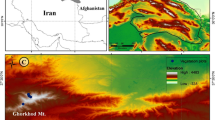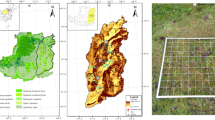Abstract
The Qinling-Daba Mountains are the main body of China’s North-South Transitional Zone. Analysis of the north-south gradual variation of vegetation components is significant for understanding the structural diversity and complexity of this transitional zone. In this study, based on survey data of plant communities, the eastern Qinling-Daba Mountains is divided into four geographic units: the north flank of eastern Qinling Mts., south flank of eastern Qinling Mts., north flank of eastern Daba Mts. and south flank of eastern Daba Mts. We also explore division of regional climate according to areal differentiation of plant-species, community structure and species-richness, respectively. The results show that, (1) at plant-species level, there are mainly northern plants in north flank of eastern Qinling Mts. with evergreen species and fewer northern plants in south flank of eastern Qinling Mts.; there are mainly southern plants in eastern Daba Mts. (2) At community structure level, there are 4 formations (3 northern formations and 1 widespread formation) in north flank of eastern Qinling, 6 formations (3 northern formations, 1 southern formation, and 2 widespread formations) in south flank of eastern Qinling, 4 formations (2 southern formations and 2 widespread formations) in north flank of eastern Daba Mts., and 3 formations (3 southern formations) in south flank of eastern Daba Mts. In terms of the numbers and properties of formations, there is a mixture of northern and southern formations only in the south flank of eastern Qinling Mts. (3) At species-richness level, the diversity of families, genera and species decreased with increasing latitude, but the mixing of northern plants and the southern plants began to occur in south flank of eastern Qinling Mts. This means that the south flank of the eastern Qinling Mts. serves more suitably as the dividing line between China’s warm temperate and subtropical zones.
Similar content being viewed by others
References
Cai H J, 1990. Study on the floristic spermatophyte of Xiaoqinling Natural Reserve in Henan. Journal of Henan Agricultural University, (2): 261–268. (in Chinese)
Ding S Y, Lu X L, 2006. Comparison of plant flora of Funiu Mountain and Jigong Mountain Natural Reserves. Geographical Research, 25(1): 62–70. (in Chinese)
Fang J Y, 1991. Eco-climatological analysis of the forest zones in China. Acta Ecologica Sinica, 11(4): 377–387. (in Chinese)
Fang J Y, 2001. Re-discussion about the forest vegetation zonation in eastern China. Chinese Bulletin of Botany, 43(5): 522–533. (in Chinese)
Fang J Y, Wang X P, Shen Z H et al., 2009. Methods and protocols for plant community inventory. Biodiversity Science, 17(6): 533–548. (in Chinese)
Gentry A H, 1988. Changes in plant community diversity and floristic composition on environmental and geographical gradients. Annals of the Missouri Botanical Garden, 75(1): 1–34.
Shen Z H, Hu H F, Zhou Y et al., 2004. Altitudinal patterns of plant species diversity on the southern slope of Mt. Shennongjia, Hubei, China. Biodiversity Science, 12(1): 99–107. (in Chinese)
Hu X Y, Yang H, Li N et al., 2017. Research on the plant diversity and its conversation in Henan Liankang Mountain National Nature Reserve. Modern Horticulture, (4): 133–134. (in Chinese)
Huang B W, 2004. Modern Physical Geography. Beijing: Science Press. (in Chinese)
Gauch H G, 1989. Yang C, Yang Z Z trans. Multivariate Analysis in Community Ecology. Beijing: Science Press. (in Chinese)
Jiang Y, Tian L S, Lei M et al., 1990. Analysis of the regional differences of floristic composition and the nature of vegetation in the lower zone on the eastern slope of the Helan Mountain range. Acta Phytoecologica et Geobotanica Sinica, 14(1): 46–54. (in Chinese)
Kang M Y, Zhu Y, 2007. Discussion and analysis on the geo-ecological boundary in Qinling range. Acta Ecologica Sinica, 27(7): 2774–2784. (in Chinese)
Kerkhoff A J, Moriarty P E, Weiser M D, 2014. The latitudinal species richness gradient in New World woody angiosperms is consistent with the tropical conservatism hypothesis. Proceedings of the National Academy of Sciences, 111(22): 8125–8130.
Lei M, 1999. Vegetation of Shaanxi. Beijing: Science Press. (in Chinese)
Li C N, 2006. Biodiversity and protection of biodiversity in Niubeiliang National Nature Reserve in Shaanxi Province [D]. Xianyang: Northwest A&F University. (in Chinese)
Li J Y, Feng X, Yin J B et al., 2020. Change analysis of spring vegetation green-up date in Qinba Mountains under the support of spatiotemporal data cube. Journal of Sensors, (2):1–12.
Li Z J, Chen S B, 2011. Community Ecology. Beijing: China Meteorological Press. (in Chinese)
Liu J J, Pan Z W, Qin F et al., 2020. Estimation of air temperature based on MODIS and analysis of mass elevation effect in the Qinling-Daba Mountains. Geographical Research, 39(3): 735–748. (in Chinese)
Ma D W, 2009. Experimental and Practice Course Phytogeography. Beijing: Science Press. (in Chinese)
Qin Y F, 2011. The plant communities’ vertical distribution and the species’ diversity in Funiu Mountain Nature Reserve. Chinese Horticulture Abstracts, 27(1): 186–187. (in Chinese)
R Development Core Team, 2017. R: A Language and Environment for Statistical Computing. Vienna: R Foundation for Statistical Computing.
Rohde K, 1992. Latitudinal gradients in species diversity: The search for the primary cause. Oikos, 65(3): 514–527.
Shen M C, 2010. Biodiversity Research and Conservation on Qinling Mountains in China. Beijing: Science Press. (in Chinese)
Shi P L, Li W H, Wang J X et al., 2000. Species-abundance relation of herb communities in subalpine timber-line ecotone of Wolong Natural Reserve, Sichuan province, China. Acta Ecologica Sinica, 20(3): 384–389. (in Chinese)
Song C S, 1994. Scientific Survey of the Jigong Mountain National Nature Reserve. Beijing: China Forestry Publishing House. (in Chinese)
Song Y C, 1999. Perspective of the vegetation zonation of forest region in eastern China. Acta Botanica Sinica, 41(5): 541–552. (in Chinese)
Song Y C, 2016. Vegetation Ecology. 2nd ed. Beijing: Higher Education Press. (in Chinese)
Wang B S, 1987. Phytocoenology. Beijing: Higher Education Press. (in Chinese)
Wang D B, Ji S Y, Chen F P, 2001. A review on the species diversity of plant community. Chinese Journal of Ecology, 20(4): 55–60. (in Chinese)
Wang J, 1985. A preliminary study on the flora of the spermatophyta in the Dabie Mountain in Henan. Acta Agri-culturae Universitatis Henanensis, (3): 117–131. (in Chinese)
Wang L S, 2004. Study on plant resource of nature preserve in Funiu Mountain of Henan Province II. Shaanxi Forestry Science and Technology, (3): 10–13. (in Chinese)
Weiser M D, Swenson N G, Enquist B J et al., 2018. Taxonomic decomposition of the latitudinal gradient in species diversity of North American floras. Journal of Biogeography, 45(2): 418–428.
Wu G H, Cai Y L, 2004. Integrated Physical Geography. 2nd ed. Beijing: Higher Education Press. (in Chinese)
Yang C F, Sun S G, Liu X et al., 2001. A preliminary study on the vegetation of Jiugong Mountain Nature Reserve and its characteristics. Journal of Wuhan Botanical Research, 19(6): 475–482. (in Chinese)
Yao Y H, Suonan D Z, Zhang J Y, 2020. Compilation of 1:50,000 vegetation type map with remote sensing images based on mountain altitudinal belts of Taibai Mountain in the North-South transitional zone of China. Journal of Geographical Sciences, 30(2): 267–280.
Ye Y Z, Qu W Y, Huang Y C, 2002. Scientific Survey of the Liankang Mountain National Nature Reserve. Beijing: Science Press. (in Chinese)
Ye Y Z, Wang S Y, Li P X, 1992. A study on the spermatophyta flora in the Jigong Mountain natural sanctuary in south Henan. Plant Science Journal, 10(1): 25–34. (in Chinese)
Ying J S, 1994. An analysis of the flora of Qinling Mountain range: Its nature, characteristics and origins. Acta Phytotaxonomica Sinica, 32(5): 389–410. (in Chinese)
Yu X F, 1958. Physical geography in Qinling Mountain. Journal of South China Normal University (Social Science Edition), (3): 157–175. (in Chinese)
Zhang B P, 2019. Ten major scientific issues concerning the study of China’s north-south transitional zone. Progress in Geography, 38(3): 305–311. (in Chinese)
Zhang B P, Tan J, Yao Y H et al., 2009. The Geo-info-spectrum of Montane Altitudinal Belts. Beijing: China Environmental Science Press. (in Chinese)
Zhang H D, Wang B S, Hu Y J et al., 1983. The plant communities on the north slope of Dawu Mountain, Kowloon. Ecological Science, 2(1): 1–10. (in Chinese)
Zhang J T, 2004. Numerical Ecology. Beijing: Science Press. (in Chinese)
Zhang L X, Li S F, 1998. Characters of seed plants flora and vegetation from Yixing Forest Nature Reserve in Jiangsu Province. Journal of Plant Resources and Environment, 7(4): 1–7. (in Chinese)
Zhang X Z, Zhang Z Y, 1979. A preliminary discussion on the northern boundary of subtropical zone in China: based on the distribution of broadleaf woody evergreens on the Qinling Mountain. Acta Geographica Sinica, 34(4): 342–352. (in Chinese)
Zhang Z Y, Yuan Y M, 1989. The geographical distribution and floristic characteristics of genera endemic spermatophytes to China in Qinling. Acta Botanica Boreali-Occidentalia Sinica, 9(1): 32–39. (in Chinese)
Zhao F, Zhang B P, Zhu L Q et al., 2019. Spectra structures of altitudinal belts and their significance for determining the boundary between warm temperate and subtropical zones in the Qinling-Daba Mountains. Acta Geographica Sinica, 74(5): 889–901. (in Chinese)
Zhao S Q, 1983. A new scheme for comprehensive physical regionalization in China. Acta Geographica Sinica, 38(1): 1–10. (in Chinese)
Zhou B H, Yu S J, 2008. Characteristics and environmental functions evaluation of the Pinus taiwanesis community in Tianzhu Mountain. Geographical Research, 27(2): 257–265. (in Chinese)
Zhou T R, Liu P T, 1956. Topography and Soil in China. Beijing: The Commercial Press. (in Chinese) Zhu K Z, 1958. Subtropics of China. Chinese Science Bulletin, 9(17): 524–528. (in Chinese)
Author information
Authors and Affiliations
Corresponding author
Additional information
Foundation
National Scientific and Technological Basic Resources Investigation Project, No.2017FY100900
Zhang Xinghang (1992–), PhD Candidate, specialized in mountain geography and ecological environment.
Zhang Baiping (1963–), Professor, specialized in physical geography and applied GIS.
Rights and permissions
About this article
Cite this article
Zhang, X., Zhang, B., Wang, J. et al. North-south vegetation transition in the eastern Qinling-Daba Mountains. J. Geogr. Sci. 31, 350–368 (2021). https://doi.org/10.1007/s11442-021-1840-1
Received:
Accepted:
Published:
Issue Date:
DOI: https://doi.org/10.1007/s11442-021-1840-1




